Back
For the past six months, Carnegie Museum of Natural
History’s
most famous residents—Diplodocus carnegii, Apatosaurus
louisae, Allosaurus fragilis, Protoceratops andrewsi, and
Tyrannosaurus rex —have been getting badly needed
makeovers in the New Jersey studios of master dinosaur
preparator Phil Fraley. Their bones are being cleaned and
preserved, then they’ll be reassembled
in dynamic, scientifically accurate poses before being disassembled,
again, for their return to Pittsburgh.
Soon, Carnegie’s
famous five will be joined by three lesser-known dinosaurs
that for decades hung encased in
ancient rock and plaster on the walls of the museum’s
Dinosaur Hall. But first, museum fossil preparators must
complete the arduous work of freeing the well-preserved
skeletons—some of the best-preserved of
their respective species ever found—from stubborn
rock that, at times, seems unwilling to release them.
Their names are Camptosaurus, Dryosaurus, and Corythosaurus,
and when Dinosaurs in Their World opens in late-2007,
they’ll
be standing again for the first time in millions of years.
Camptosaurus and Dryosaurus, both unearthed in the early
1900s during Carnegie digs in Utah, will permanently
reside in displays dedicated to the Late Jurassic period
(159-144 million years ago). Corythosaurus, obtained
as part of
an exchange with the Royal Ontario Museum in 1940, will
be placed beside other creatures from the Late Cretaceous
period (99-65 million years ago).
“
It’s really amazing when you think about it,” says
Matt Lamanna, the museum’s assistant curator of
Vertebrate Paleontology and chief dinosaur researcher. “We’re
removing the remains of these dinosaurs from the rock
they died in millions of years ago—some of it in
PaleoLab, in full view of our visitors.”
The people
doing the work are Paleontology Laboratory Manager Allen
Shaw and Scientific Preparators Dan Pickering,
Alan
Tabrum, Yvonne Wilson, and Norm Wuerthele. In her journal
entries documenting her early work on Camptosaurus, published
on Carnegie Museum of Natural History’s
website (www.carnegiemnh.org), Wilson likens the process—the
chiseling, the chipping, the drilling—to “trying
to wear away a mountain with a dress pin.”
And
there’s more where that came from. A lot more.
Following
are some slices of life from PaleoLab over a six-month
period in 2005, courtesy of Wilson, who has
spent
many long days with Camptosaurus. And, yes, a year
later, her work continues.
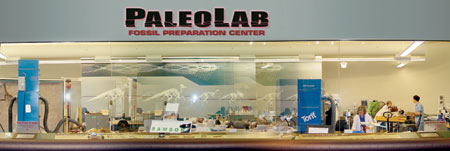 |
| Journal Entries: From Yvonne Wilson |
January 13, 2005, 5:20 PM (first entry)
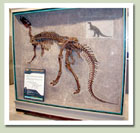 We have taken the Camptosaurus that has been in Dinosaur Hall since 1925 and
moved it into PaleoLab. The skeleton is mounted into a wall panel. Instead
of rock, it is largely encased now in plaster. Our goal is to free the fossil
in order to make a freestanding, mounted dinosaur. And this is the start of
it. We have taken the Camptosaurus that has been in Dinosaur Hall since 1925 and
moved it into PaleoLab. The skeleton is mounted into a wall panel. Instead
of rock, it is largely encased now in plaster. Our goal is to free the fossil
in order to make a freestanding, mounted dinosaur. And this is the start of
it.
There is still
original rock, or matrix, surrounding the torso.
This rock, from the Morrison Formation (in
Utah), is known to be extremely hard, sometimes
harder
than cement. That could be part of the reason the original workers left this
specimen mostly embedded in the rock. Another reason, though, is that it
is nicely
articulated (meaning, the bones are still in the same place as they were
in the body). I can only hope it will cooperate.
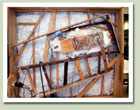 January 28, 2005,
4:19 PM January 28, 2005,
4:19 PM
Our dinosaur curator, Matt Lamanna, asked us
to check out the quality of the bone on the "underside" of
the specimen. He wanted to make sure the fossil
would hold up once it is taken out of the rock.
We opened up the
back fully. This is the "jacket," or
the plaster and burlap package in which paleontologists
wrap their fossils in order to
ship them
home from the field. There is a large board supporting the back of the jacket.
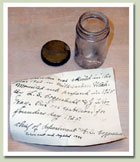
Hey, what is this?
They left us a message in a bottle!
The workers
who put the exhibit together left a note saying
where and when the specimen was
found (northeastern Utah, 1922), and who worked
on the mounting
project in 1925. In a second
handwritten message, there is a notation that the exhibit was taken down
and "lighted" in
1934.
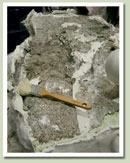 March 30, 2005,
11:20 AM March 30, 2005,
11:20 AM
Just looks like a hunk of rock now. Yet a dinosaur
lurks beneath.
I attack the rock
lump with hammer and chisel. On rock this hard
(arrrg!),
this method is
much faster than an airscribe—though
I still feel like I am trying to wear away
a mountain with a dress pin.April 6, 2005,
11:42 AM
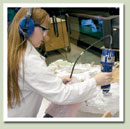 … My arms ache with the effort at the end of the day, and I can feel the
ringing of the chisel in my hand even after I stop to take a break. … My arms ache with the effort at the end of the day, and I can feel the
ringing of the chisel in my hand even after I stop to take a break.
 May 21,
2005, 1:17 PM May 21,
2005, 1:17 PM
As I work along the spinal column, I am finding things that are both lovely
and awful at the same time—ossified tendons. These are mineralized
tendons that helped stiffen the backbone and support the tail of the
dinosaur. They
are frequently found in ornithopod dinosaurs (ornithopods include dinosaurs
such
as Iguanodon, Hadrosaurus, and my Camptosaurus). I am consulting with
other preparators to see if I can save these slender tendons.
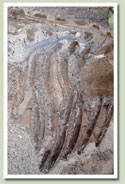 June 5, 2005, 6:34
PM June 5, 2005, 6:34
PM
I have been isolated with this fossil in sensory-depriving
mask, goggles, bandana, earplugs, and earphones.
One ends up in a "zone" where the
fossil becomes the only thing in the world
with you. In this mode, I have unearthed
most of
the ribs.
The whole beast
looks like a side of beef these days.
After
I free the ribs from the spinal column, my
plan is to roll the jacket so that I can
attack the vertebrae from the opposite side.
|
|
Back
| Top |